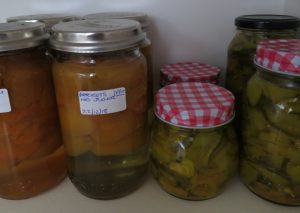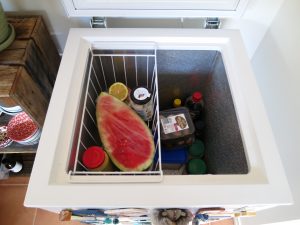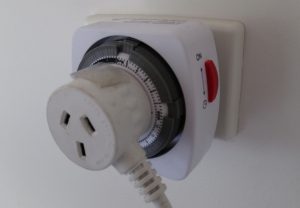With a little more effort, you can have an even cheaper food storage system that provides some buffer against a power failure or supermarket supply chain failure using two methods: Preserving and a chest fridge.
Preserving:
- Growing some herbs, greens and veggies is super easy in a small space and means that you can have fresh lettuce, kale and herbs without the need for refrigeration; just pick them when you need them.
- For already keen gardeners, fermenting, canning and drying produce are time tested low energy food storage methods that provide alternative food storage.
- Fermenting, pickling and drying are preferable as they require very little energy for the preserving process and can be done with minimal time and equipment.

The chest fridge:
- A chest fridge is just a chest freezer that has been converted to run as a fridge.
- Chest freezers typically have better insulation than upright fridges and they don’t leak cold air out of their seals like upright fridges do because the seals are up the top (cold air falls, hot air rises).
- A chest fridge can also maintain its temperature for much longer periods in a blackout.
- It should last longer than an upright fridge given that a freezer’s compressor and motor are designed for a longer duty cycle than what refrigeration requires. It other words, it is over-engineered for the job.
Measured with a simple power meter, our 100 litre chest fridge uses 0.1kWh per day in winter and up to 0.25kWh in summer, compared to 1.5kWh per day on average for our old upright fridge/freezer [1].
Compared to a 100 litre upright fridge which costs the same to buy, our chest fridge uses just a quarter of the energy on the grid to do the same job which saves us $60 a year.

The simple way to convert a chest freezer into a fridge:
- You can use a plug in and play option where you hang a temperature sensor probe inside the fridge and plug your freezer into a controller that is plugged into your power supply (mains or battery).
- The control box simply overrides the thermostat in your freezer to run it as a fridge instead which requires no modification to your freezer.
- We have seen such kits available from the US online and one version available in Australia (see link 2 below) [2].
A more stealth option:
- If you want a chest fridge that is more stealth and you don’t mind putting in a little extra work, you can buy a thermostat that replaces your existing freezer thermostat [3].
- That’s what we run and it works reliably. The only small issue we have is that the bottom of the fridge can get a little icy so we use a simple timer switch to limit how long the fridge can run for.
- If you go down this path, just remember to get a freezer that operates with a simple mechanical thermostat.

Our chest fridge cost us $260 to set up including the new purchase of the freezer. This cost should be mostly covered by the sale of your old fridge and will save $140 a year if you are already storing food like a smart renter.
Further Reading:
[1] Here’s an informative PDF from Tom Chalko about how chest fridges work and why they save energy:
https://mtbest.net/chest_fridge_1.pdf
[2] https://mtbest.net/freezer-to-fridge-thermostat.html[3] We have only found one kit in Australia that is a mechanical thermostat replacement for a freezer thermostat. There are two versions but we have found that the cheese/wine fridge thermostat runs too warm.